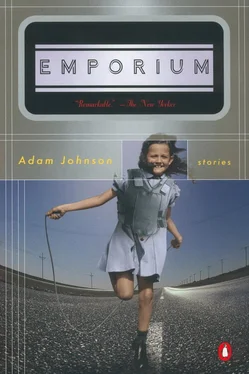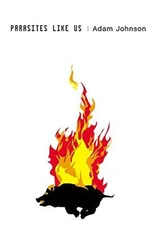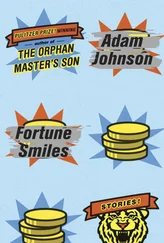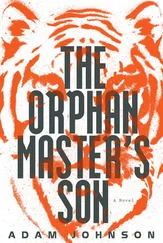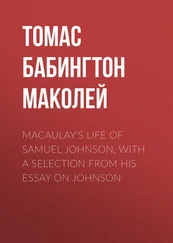Ralph was a little leery of my enthusiasm, but to us things had always been clear: the tiles needed sorting, and the solution was to dive in and get to work. The task was impossible on the surface, but you could picture a day when all the tiles had found their homes, and this knowledge carried us through long stretches of sorting where we didn’t speak, where there were only the soft clicks and chinks of subtle progress. At home, there was no preparation for my father. No one vacuumed or cleaned the guest towels. No one whistled the Wolverine fight song. No one found the magazines I looked at, red under the hot bath lamp, as I sweated and stared into the eyes of women who seemed to know the primitive math I was working on their bodies. There was no hiding of a robe for a man who may or may not have prowled the seventeenth parallel.
When I rode up on Saturday morning, Ralph stood staring at his dog Hans, dead of unknown causes in the mud behind the house. There was a water spigot on the side of the tile palace that dripped, and here was where the dog liked to dig and wallow. To keep him from burrowing under the tile bin, Forst always threw the cracked tiles in the hole, and this is where Hans was, sprawled on the broken shards, tongue in the mud. I approached and we stood silent for what seemed a great while.
“Dang,” Ralph eventually said and marched off to get Forst.
Hans’s coat was a little past charcoal, near black where his fur was soaked, and lying there, mouth open, gums graying, he looked lost and thirsty.
Ralph came back with Forst, who asked “what the hell?” of nobody in particular, and stood in shorts and socks sucking his fingers. I think he’d been eating barbecue potato chips. He licked the palm of his hand with several long strokes, and then nudged Hans with his toes. Next he kneeled down in the mud and used his thumb to open Hans’s eye. “Shit,” he said and hooked the dog’s upper canine with his finger, swiveling its snout up, the throat falling open, so Forst could look inside. We leaned in close. He sniffed the dog’s mouth but gave no reaction.
Forst then touched the dog’s stomach delicately, tenderly almost, before putting his ear to Hans’s belly, his other arm cautioning us to be still. I held my breath.
After a while he turned to us, and Forst, on his knees, stared straight in Ralph’s eyes. “Did I teach you to care for that dog?” He pointed down but none of us looked.
Forst got up and shuffled through the yard in his socks, pausing to search here or there in the grass with his toes, and I was pretty sure he was looking for a piece of rope. Ralph crossed his arms and squeezed his shoulders while we watched, but Forst only kicked around the yard for a while before disappearing.
It gave me the creeps to see Forst like that, and I didn’t know what to think. Ralph dropped his arms to his sides after Forst left, and the handprints on his shoulders made it look like he was being held, the way someone steadies you before they kiss you or punch you good. I felt held too, that day, that summer, but I had no such outward way to show it.
Forst returned with a short, hooked-blade linoleum knife and simply opened Hans up. The sawing motion jarred the dog in quick convulsions, briefly animating it. Suddenly, whole volumes of seething, blind worms poured milky pink from Hans’s belly. We all stepped back and watched them writhe.
“Jesus,” Forst said.
“Dang,” Ralph said.
But I said nothing. It was a moment of swirling clarity for me, and I wished I could see the inner workings of all things so plainly, that someone would touch and listen, dig even, for all the strange things I felt growing inside me. I had to sit down. Through the sliding glass door I could make out Ralph’s mother standing alone, observing us from the dark of the house. She looked on us as strangers, like she was already trying to find a way to put this behind her as she watched her husband wipe a knife on his sock. Looking at her, I considered the possibility it was a submarine my father was really on, and I hoped he wore a similar face every time he surfaced on the other side of the world.
Ralph’s mother balanced a yellow plastic laundry basket on her hip, and through the greasy dog-paw prints on glass door, I could see the the lip of her hysterectomy scar peek out above her low-slung house-shorts. I wanted to go to her, just to touch her maybe, but what good would that do? From the grass, I stared at the scar and wondered if my mom had maybe worked on that uterus in her pathology lab, if she had held it up close in the light and peered inside, or just dry-froze it for cross-sectioning.
I was pouring liquid argon into a bowl of flatworms when Secretary Mulroney arrived at our lab. He’d flown through the perpetual dark and taken a Sno-Cat thirteen kilometers from a tiny icefield landing strip before snowshoeing blind along frozen lifelines. I was doing some side research on reanimation, and the worms had just begun to crackle and flip in the Pyrex when Mulroney pushed his way through our storm-proof doors, his war medals glowing amber in the light of the heaters.
Mulroney had never come out to our Tundra Lab before, so it was clear something big was up, something far too important to risk using the scramble phone. He stomped his boots and grabbed a pair of red UV goggles — we’d been having problems with gamma rays. Scotty lowered his L-7 analyzer and groaned. Vu killed the dyno-burner and spit on the floor. But I wasn’t going to piss and moan. I believed in what we were doing. We hadn’t bathed since Boxing Day — that’s how serious we were. We all turned to Dr. Q for a reaction.
Dr. Q lifted his head slightly, bringing his eyes to bear on our surprise visitor, as if he knew right there that we were about to begin the greatest scientific odyssey in the history of Canadian weapons development. I looked at Q’s eyes, red through the lenses, and then packed my worms into the deep freeze for a week’s vacation, at which point I hoped to revive them.
“Gentlemen, I have an announcement,” Mulroney said, but as his eyes adjusted to our lab’s bright lights, he began to take in the deathray, something he’d never seen in person. He ran his eyes along the chrome transducer manifolds and walked agape down all seven meters of the glass charging tube, humming pink inside with energy. When he neared the radial accelerators, all the metal buttons flew off his jacket and raced for the field dampener, where they stuck in unison. That’s living with giant magnets.
“My word,” Mulroney said. “It’s enormous. It’s magnificent.”
Even as secretary of the Canadian Intelligence Agency, he’d probably never seen more than a rough sketch from Dr. Q. That’s how secret this was. Our supplies were dropped at night by multiprop transports, and we had no contact with the outside world. I wouldn’t even know Q’s real name until after the nitrogen accident, until it was too late.
Mulroney stood at the control panel and admired all the switches and relays. It was clear this was the CIA’s baby, and we were just building it. Mulroney could pull the plug anytime he felt like, and he didn’t have to look far for reasons. First, we were way behind on the deathray — not to mention overbudget. This was 1963, and Canada was tightening its belt. Then we’d wasted a whole year on microwaves, like fools. Finally, we lost half the lab in the rabbit fire. Thank God for Jacques, or the mercurium cells might have burned, and then foof! — good night Canada. But the problems were never ending. We’d get the targeting system running, and then there’d be trouble in beam modulation-land. We’d tune the spectrum stabilizer, and the ni-cad core would degrade (just the smell of cadmium can still turn my stomach). Dr. Q had to invent Level IV polymers just to make the O-rings. Invent them! There was no deathray book. We were writing it.
Читать дальше
